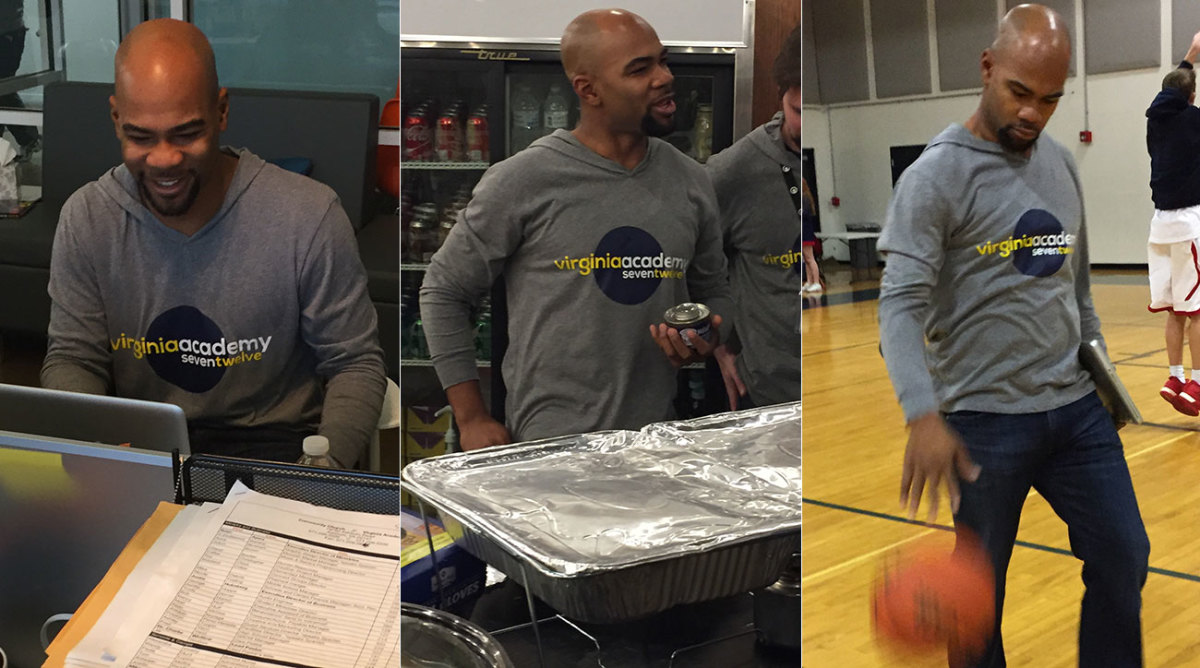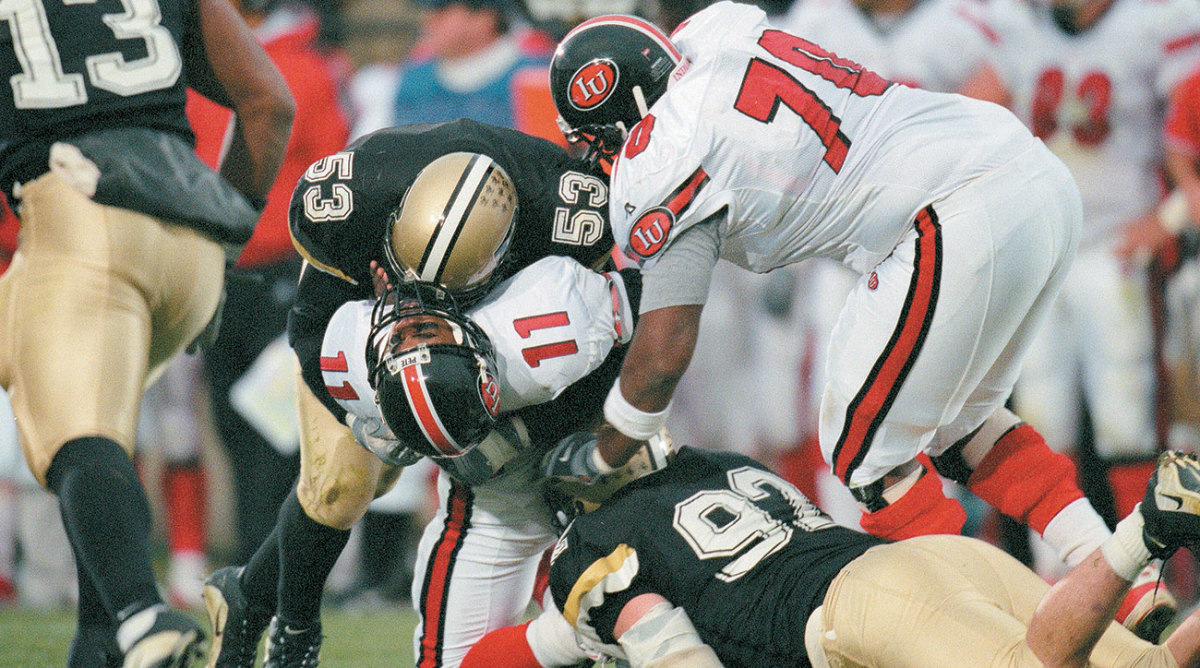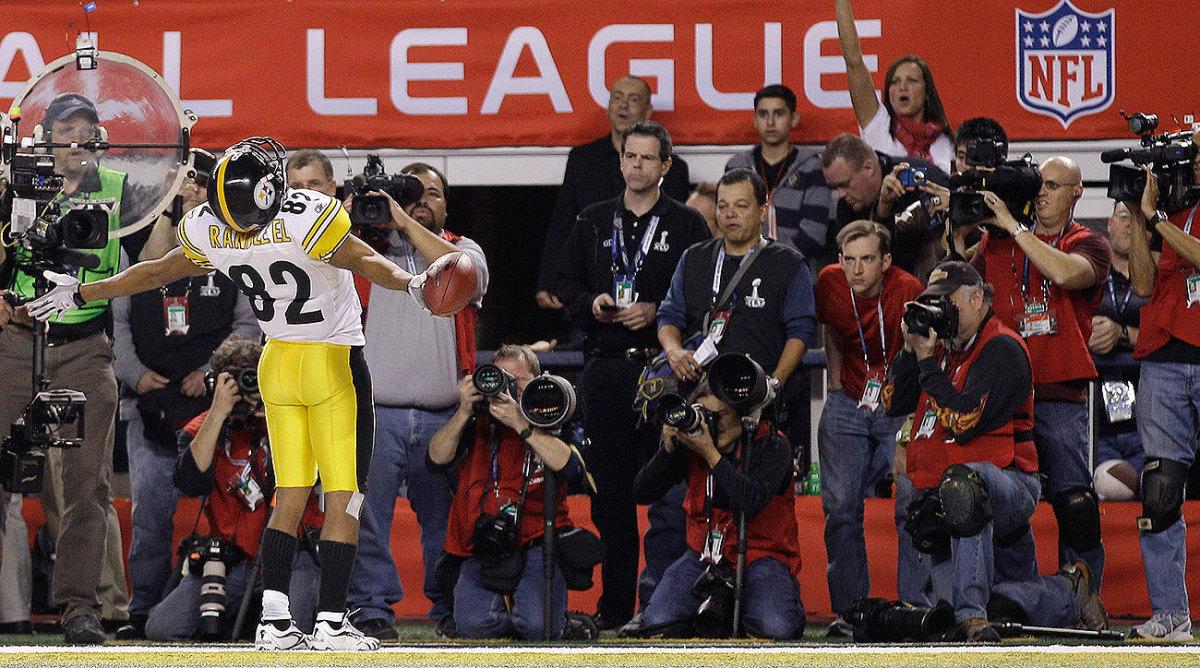Antwaan Randle El has no regrets and plenty on his plate in life after Super Bowl glory

ASHBURN, Va. — “We need more plates,” a voice calls out from behind the buffet. Just like that, Antwaan Randle El takes off. He bursts out of the cafeteria, bounds down the hallway, makes a sharp cut into the auditorium, side-steps the kindergartners scattered on the floor, swipes his security card and explodes into the storage closet. Soon he re-emerges, stack of plates in hand, and just barely in time—the cheerleaders were beginning to eat their spaghetti out of styrofoam cups.
“Thanks Coach El,” one says, transferring pasta from cup to plate. Before he can reply, another situation requires his attention. Several, actually. The paper towel supply is dwindling. One of the basketball players forgot his jersey at home. The video camera used to film the team’s games is nowhere to be found. Nor is the cash box to collect admission fees. And the bus is about to leave.
“JV, get on the bus,” Randle El bellows, before darting back out of the room. He locates a roll of paper towels, digs a white basketball jersey out of a cardboard container, finds a cash box in a nearby classroom, and borrows a GoPro. As he hustles around the floor checking off tasks, he abruptly stops at one student slumped on a couch. You all right?Just tired. He is back on the move.
It’s coming up on 5 p.m. at Virginia Academy, a K-12 private Christian school in Ashburn, and the school’s athletic director is a blur of constant motion. He finds himself regularly apologizing to a visiting reporter struggling to keep up with his pace. But, despite lagging a few steps behind, this much is clear—the former trend-setting college quarterback, erstwhile multifaceted Steelers and Redskins receiver, and Super Bowl XL hero remains as versatile a contributor as they come.
After The Helmet Catch, David Tyree took a winding road to his second Giants job
That morning, Randle El sits in the ornate lobby of the school. Three chandeliers dangle overhead, near the floor-to-ceiling windows, exposed brick pillars and mural, and in-house cafe. He’s posted up on a couch next to the front door, personally greeting just about every student who walks past by name.
He makes a quick stop at his desk—it’s the one bestrewn with a yellow Terrible Towel—to jot down a few notes. A placard affixed to the translucent desk divider lists his name and his “strengths,” derived from a test that every teacher and administrator at the school must complete. His read: positivity, achiever, woo (short for “winning others over”), communication, developer. Forever the five-tool athlete.
When asked about his day-to-day duties, Randle El rattles off an interminable list—from scheduling to international recruitment (more on that later), to setting up and chaperoning class trips (the following day, all of the high school boys are headed to the Wizards game), to being in constant communication with teachers, to making regular calls with students’ parents and athletic directors at other schools, to serving as a sounding board for athletes and non-athletes alike. His responsibilities also entail the more menial tasks, ones that may not be part of his actual job description, ones that require him to run back and forth through hallways.
“Whatever they need me to do,” Randle El says, “I do.”

If it is not clear by now, Antwaan Randle El wants to set the record straight. Despite what you may have heard, he is not debilitated. Physically or mentally. In fact, his workload these days is just about as wide-ranging as it was when he was the league’s most amorphous offensive weapon.
“I’m good,” he says. “You see. I’m good.”
Around this time last year, Randle El told the Pittsburgh Post-Gazette that on certain days he had trouble walking down the stairs, at times he has memory lapses, and that if he could go back he would choose to play a different sport. Through what can be described as a game of Headline Telephone, this morphed into reports elsewhere (including on SI.com) that he’s handicapped, cognitively impaired or regretted playing football.
“I never said I regret playing the game,” Randle El clarifies now. “I just said if I could go back and do it again, I would play baseball. [Because] I’d still be playing today.”
John Kasay's fateful Super Bowl kickoff stays with him, but doesn't haunt him
He admits that his knees and ankles do regularly ache and that he works out only once or twice a week—partly because he’s busy and partly because it hurts. But he calls the pain “normal football stuff.”
“I’ve been playing football since I was six,” he continues. “I played nine years in the league. That’s a long time. Whoever you talk to [that has done the same] is going to have some type of pain.”
He says he had two diagnosed concussions in his career, one in college and one in his final season with the Steelers. By diagnosed concussions he means occasions when he was knocked unconscious. Several other times, he says, he “got dinged and stayed in [the game].” Looking back he believes those were also likely concussions, which is why now, he says, he urges his students to remove themselves from games if they “get dinged.”
Any memory trouble he does have, he ascribes to his chaotic job and family life, with a wife and six children—calling it, again, “normal stuff.”
“But,” he adds, “I do question if it could escalate more later.”

A three-sport star in high school, Randle El was drafted by the Cubs as a senior but chose to play quarterback for Cam Cameron (and guard for Bobby Knight) at Indiana because his parents said he needed to get a college degree. He arrived in Bloomington in 1997 as a partial qualifier and was forced to redshirt his freshman season. In his first collegiate game the following year, he amassed 467 yards and six touchdowns, smashing the school’s total yards record.
Mired on losing teams as a Hoosier, Randle El still managed to finish sixth in the Heisman Trophy voting in 2001, his senior season. “Had we won a couple more games, he would have been the Heisman winner, hands down,” Cameron says. “He was the best player in the country.”
Upon the conclusion of Randle El’s collegiate career, he was the No. 1 rushing quarterback in NCAA history, the first ever member of the 40-40 club (40 rushing and 40 passing touchdowns), the first player to pass for 6,000 yards and rush for 3,000 yards, and the first to accumulate at least 2,500 yards of total offense in four consecutive seasons. Still, since he was only 5’ 9” and 185 pounds, NFL teams told him he’d have to switch to receiver.
Drafted by Bill Cowher’s Steelers in the second round, Randle El seamlessly transitioned into a variety of new roles. He was the team’s slot receiver, kick and punt return specialist and trick play virtuoso. During Ken Whisenhunt’s two seasons as Steelers offensive coordinator, Randle El never missed an opportunity to remind the coach that he could still play quarterback. To maximize his skill set, and to “feed that itch to throw the ball,” as Randle El puts it, the team developed plays specifically for him—direct snaps, shovel passes, end-arounds, reverse runs, reverse passes. His success with such plays was historic. Among players with at least 20 pass attempts in their career, Randle El has both the best completion percentage (81.5%) and QB rating (156.1) in NFL history.
“The root of everything was his ability to do so many different things,” Whisenhunt says. “That was a tremendous asset for us as an offense.”
Which brings us to Fake-39 Toss X-Reverse Pass, the play that clinched Super Bowl XL. Whisenhunt drew it up. The design: Ben Roethlisberger would pitch the ball to his left to running back Willie Parker, who would then hand off to Randle El on the reverse, who would then attempt to heave the ball downfield to Hines Ward. On the Friday before the Super Bowl the team ran the play at practice and failed repeatedly. Randle El kept overthrowing Ward, leading him too far and causing him to abortively dive for the ball. Still, the night before the game, Cowher pulled Whisenhunt aside and reminded him that since they didn't have a game the following weekend, they might as well utilize everything in their arsenal.
The coaches discussed possible situations where they could run the play. Neither of them envisioned it’d be with nine minutes left in the fourth quarter, only up by four points. But the next day, when Whisenhunt walked up to Cowher on the sideline and told him the upcoming sequence—a QB draw with Roethlisberger, followed by the reverse pass—the head coach simply nodded.
When the play call came in, Randle El’s eyes widened. He had been worried they weren’t going to call it. As he got to the line of scrimmage, the only thought in his mind was Don’t get a false start. Rolling to his right, aided by a key block from Roethlisberger, Randle El launched a spiral fifty yards. As it left his fingers. he thought he overthrew it again. But the pass hit Ward perfectly in stride, and he skipped into the end zone to seal a Super Bowl win.
“That,” Randle El says, “changed my life.”
• From the Vault (2006): “Hearts of Steel”, the story of Pittsburgh’s Super Bowl XL win
All three coaches echo some variation of the same refrain when told what their former playmaker is up to these days: That doesn’t surprise me. They remember him as an always-jovial locker room leader, quick to offer assistance wherever needed, concerned with the well-being of others. “And if you ask people around him in junior high school,” Cameron says, “they would tell you the same thing.”
After sustaining a knee injury during the 2011 NFL lockout and then getting cut by the Steelers, Randle El’s only suitors were bottom-dwelling teams. At that point in his career, he says, he only wanted to play for a contender. So he decided to retire and start The EL Foundation, a charity that helps underserved children. Then, in 2013, Virginia Academy officials approached a friend of his about serving as its athletic director; the private Christian school was expanding to include grades nine through 12. The friend recommended Randle El for the job instead.
A few months after the school year began, a man named Greg Hendricks reached out to Randle El. Hendricks is a pastor at The Rock Church in San Diego and would frequently travel to Nigeria to run a basketball center called Jesus Christ Camps. There, Hendricks met a soft-spoken 6' 9" teenager named Ejike Obinna and urged Randle El to bring him over to his school. The athletic director didn't know that was even possible, but the idea of adding a raw but promising talent to a team that pulls from a high school population of about 60 students in total—and expanding his charity's mission into another continent—piqued his interest.
He spoke with school administrators, who filled him in on the process of obtaining I-20 forms and visas to secure Obinna’s relocation to the U.S. and gave their blessing to go forward. Randle El says he talked with Obinna’s mother on the phone for hours and secured the funding through sponsor donations from his foundation. Soon, Obinna was walking through customs at Dulles, and the athletic director was there to greet him.
In the four years since, Randle El has brought over three more student-athletes to play basketball for VA, two from Nigeria and one from Lithuania. They also have a point guard, Jahlil Jenkins, who commutes every day from West Virginia. Last year, only the second season the school fielded a varsity basketball team, it won the VISAA Division III state basketball title. Obinna has since signed to play at Vanderbilt, while Jenkins has committed to Farleigh Dickinson—the first D-I athletes in the school’s history.
Randle El understands that some look askance at the practice of bringing kids over from other countries to play basketball. He even says that he knows of schools around the country that do so in irresponsible ways—bringing kids over without ultimately having a place to house them, or fast-tracking athletes to graduate without giving them the education to be academically eligible in college.
“We aren’t here to just get the kid and then kick the kid out,” Randle El says. “If kids come here, I make sure they have what they need. I know what they are getting, because I’m here, I’m involved in it.”
He says he uses the fact that he took the ACT four times and didn't reach a qualifying score as a teaching tool. He calls his first year at Indiana when he was academically ineligible to play “terrible,” and wants to make sure his players never have to experience something similar.
“We want the kids to leave us better than they came,” he says. “We want them to spiritually know God, and to make sure they have a great education.”
Also, he wants to win.

All the crises have been dealt with. Now, in a transient moment of stasis, Randle El stands behind the Virginia Academy bench as the varsity basketball game begins. He coached the team for two years, but after his wife gave birth to his sixth child, he ceded responsibility. Well, sort of. Throughout the game Randle El is constantly talking to the team’s current coach, doling out tips to players, going back and forth between the scorer’s table to check foul totals, or putting his arm around the referees to gently let them know he disagreed with a call. At one point he even grabs a towel and wipes dry a wet spot on the court.
His team is leading, looking very much like a squad that is sending two players to play D-I next season. The irony is not lost on him that his school’s mascot is the Patriots—“It ain’t New England,” he quickly retorts. Late in the game, Obinna, his star player, gets smacked in the head, and Randle El notices that he still seems to be dazed a few plays later. The athletic director notifies the coach, suggesting the player should come out.
NFL draft 2017: Biggest positional needs for Packers and Steelers
Randle El admits that he contemplates a future coaching football—hopefully in the NFL, maybe once his youngest son (who is two) is in school. Just a few days earlier he talked with current Titans head coach Mike Mularkey, who also served as his offensive coordinator in Pittsburgh, about that idea.
“He would have tremendous impact and great insight as a coach,” Cowher says. “He is a very good teacher—and that’s what you are as a coach. His ability to understand the little idiosyncrasies is what made him a special player, and I think that is also what makes great coaches.”
“If he chose to get into coaching, he could be a Mike Tomlin,” Cameron adds. “He could be that kind of coach.”
If the opportunity comes along, Randle El says, of course he’d consider it. But right now there is still much to do. The game is over, his team has won 72–64, and the athletic director is working the floor. There are players to congratulate, hands to shake, parents to greet, coaches to remind that practice is canceled tomorrow because of the Wizards trip and babies to hold. The most versatile man in the room is back on the move.
